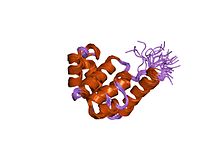- dnaB helicase
-
Replicative DNA helicase Identifiers Symbol dnaB Entrez 948555 UniProt P0ACB0 Other data EC number 3.6.1.- DnaB-like helicase N terminal domain 
nmr structure of the n-terminal domain of e. coli dnab helicase Identifiers Symbol DnaB Pfam PF00772 InterPro IPR007693 SCOP 1jwe Available protein structures: Pfam structures PDB RCSB PDB; PDBe PDBsum structure summary DnaB-like helicase C terminal domain Identifiers Symbol DnaB_C Pfam PF03796 Pfam clan CL0023 InterPro IPR007694 Available protein structures: Pfam structures PDB RCSB PDB; PDBe PDBsum structure summary dnaB helicase is an enzyme in bacteria which opens the replication fork during DNA replication. Although the mechanism by which DnaB both couples ATP hydrolysis to translocation along DNA and denatures the duplex is unknown, a change in the quaternary structure of the protein involving dimerisation of the N-terminal domain has been observed and may occur during the enzymatic cycle.[1] Initially when DnaB binds to dnaA, it is associated with dnaC, a negative regulator. After DnaC dissociates, DnaB binds dnaG.
The N-terminal has a multi-helical structure that forms an orthogonal bundle.[1] The C-terminal domain contains an ATP-binding site and is therefore probably the site of ATP hydrolysis.
In eukaryotes, helicase function is provided by the T antigen.
The DnaB helicase is the product of the dnaB gene. The helicase enzyme that is produced is a hexamer in E. coli, as well as in many other bacteria. The energy for DnaB activity is provided by NTP hydrolysis. Mechanical energy moves the DnaB into the replication fork, physically splitting it in half.
E. coli dnaB
In E. coli, dnaB is a hexameric protein of six 471 residue subunits, which form a ring-shaped structure with threefold symmetry. During DNA replication, the lagging strand of DNA binds in the central channel of dnaB, and the second DNA strand is excluded. The binding of dNTPs causes a conformational change which allows the dnaB to translocate along the DNA, thus mechanically forcing the separation of the DNA strands.
External links
References
Replication Prokaryotic
(elongation)DNA polymerase III holoenzyme (dnaC, dnaE, dnaH, dnaN, dnaQ, dnaT, dnaX) · Replisome · DNA ligase · DNA clamp · Topoisomerase (DNA gyrase)
Prokaryotic DNA polymerase: DNA polymerase I (Klenow fragment)Eukaryotic
(synthesis in
S phase)Replication factor C (RFC1) · Flap endonuclease (FEN1) · Topoisomerase · Replication protein A (RPA1)
Eukaryotic DNA polymerase: delta (POLD1, POLD2, POLD3, POLD4)
DNA clamp (PCNA)BothTermination see also DNA replication and repair-deficiency disorder
B bsyn: dna (repl, cycl, reco, repr) · tscr (fact, tcrg, nucl, rnat, rept, ptts) · tltn (risu, pttl, nexn) · dnab, rnab/runp · stru (domn, 1°, 2°, 3°, 4°)This article includes text from the public domain Pfam and InterPro IPR007693
This article includes text from the public domain Pfam and InterPro IPR007694
Categories:- Hydrolase stubs
- Protein domains
- DNA replication
- EC 3.6.1
Wikimedia Foundation. 2010.
